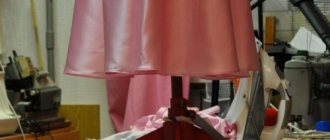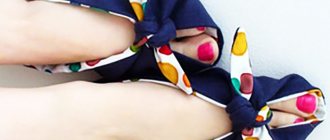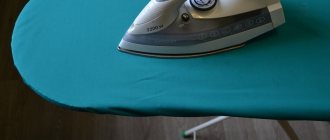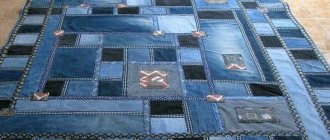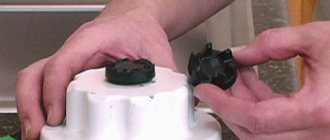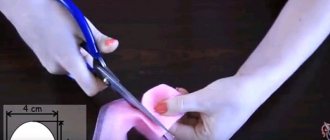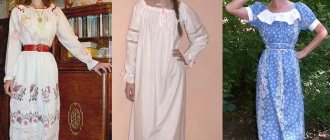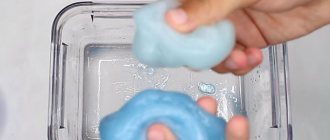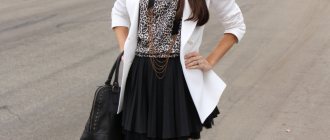Store hangers are full of monotony and lack of imagination. Don't be sad, just pick up a needle and thread. What's next? Today you will learn how to sew a T-shirt with your own hands for beginners from knitwear.
Fabric, needles, threads
Almost all store-bought T-shirts are made from knitted fabric. This fabric is easy to cut, does not stretch, is soft to the touch, breathable and easy to care for. It is with this fabric that you should start your sewing experiments.
If you are a beginner seamstress, choose fabric without a pattern. Plain fabric will be easier to sew; the pattern or stripes will need to be nicely combined at the junction of the front and back parts.
In addition to fabric and a sewing machine, you will also need:
- Sewing machine needle for stretchy fabrics;
- Simple pencil;
- Soap or chalk for drawing on fabric;
- Scissors;
- Threads for sewing machine and hand sewing;
- Pins for chopping parts;
- Ruler and centimeter.
How to cut?
In order for everything to turn out perfectly smooth, you need to make the pattern on the fabric on a perfectly flat surface. In addition, you will need scissors, tools to help with marking, a ruler and chalk.
The existing fabric must be used rationally, closely arranging the existing parts. First you need to lay out all the large patterns and patterns that have a fold. The back piece and collar need to be placed so that their center is on the fold of the fabric as they do not need to be cut. Then there are smaller parts, and so on until the smallest one. You should start cutting out only when the entire pattern is completely marked with soap or chalk on the fabric.
It is very easy to sew together the items marked on the reverse side, namely those parts that have a pair.
The front side is used to locate parts that do not have a pair, which need to be joined due to the existing pattern or design. When cutting them out, it is necessary to determine the correct location of the part.
Do not forget about the correct location of the direction of the grain of the part with the grain of the fabric. Because the fabric along the lobar thread is less likely to be distorted.
There are several types of layout:
- Longitudinal fold (Fold in half with the front side facing inward).
- Transverse (Folds inward along the transverse line with the right sides facing inward).
- Two folds (The fabric is placed along the warp threads).
- Turn (This layout is not economical, since there are many lunges. It is used when laying out parts that have an asymmetrical shape).
- Partial fold (The unfolding of the fabric is carried out according to the width, respectively, along the warp thread, since folded parts need a lot of space. The remaining parts are located on the fabric, placed in one layer).
- Rotation (It is used in the case of a small amount of fabric; it is cut and turned 180 degrees).
- Obliquely (Used if parts need to be made more movable, it is laid out, accordingly, obliquely).
It is worth noting that when choosing a layout, it is necessary to take into account the characteristics of the fabric and the pattern itself.
All about the correct layout of the pattern on the fabric in the next video.
Taking measurements
In order to take measurements from the model, you need to ask her to dress in thin, tight clothing and stand straight. Next you need to measure the following parts of the body:
- Neck circumference. The tape measure needs to be wrapped around the neck at the junction of the neck and shoulders.
- Chest circumference. The circumference of the chest and back is measured at the most protruding part.
- Waist circumference.
- Hip circumference if you are sewing a long T-shirt.
- Shoulder width. Distance from the beginning of the shoulder to the place where the sleeves are sewn in.
- Shoulder circumference. A centimeter is wrapped around the biceps with the arm lowered.
- Wrist circumference.
- The length of the sleeve. Measured from the end of the shoulder seam to the desired part of the arm.
- Back length. Measured from the base of the neck to the desired part of the hips.
Modeling
This is, first of all, the development of clothing models, in which it is important to take into account both the taste characteristics of a person and the characteristics of a person’s figure. In other words, this is a certain basis for the manufacture of a product. Modeling consists of four stages: analysis of the idea, selection of the basis for the product, introducing changes to the resulting basis and sewing the garment.
To fully understand, you need to look at some T-shirt models.
Off Shoulder T-Shirt Dress
We cut the resulting base of the T-shirt pattern into parts for the front and back. We put these details on tracing paper. To get a dropped shoulder, you need to increase the length of the shoulder seam. We put a mark and connect it with a smooth line to the armhole, we get a dropped sleeve line.
Full sleeve
A special feature is that the sleeves are cut out together with the front and back. These sleeves are varied in shape, size, and armhole depth. From the top point of the shoulder of the back and front, draw a line indicating the length. At the depth of the armhole we draw a parallel line. From the final point of the sleeve length we draw a perpendicular. Smoothly connect the points to the waist line.
Polo shirt
On the front pattern, mark the depth of the polo fastener (about 15 cm). Separately, we cut out the placket, in finished form it is 3.5 cm and 16 cm long. We shorten the sleeve to the desired length, reduce the base of the front and back by 2.5 cm along the side seam for a fit. Additionally we build a collar.
A master class on sewing a product and creating a pattern is in the next video.
With raglan sleeve
We place the front half of the sleeve and the T-shirt on top of each other, aligning the shoulder sections with the top point of the sleeve itself, which is at an angle with a slight slope. It is worth taking into account that the greater this slope, the more convex the sleeve will be.
We divide the neckline of the back in half, put point A. From point A we draw a tangent to the armhole. The intersection of the tangent with the armhole is point B. We divide AB in half, draw a perpendicular 1 cm upward, and connect it with a smooth line.
We set aside 4.5 cm along the front neckline and mark it with point A1. We connect it tangent to the armhole, we get point B1. We divide A1B1 in half, put a perpendicular of 1 cm upward, and connect it with a smooth curved line. Then, we cut all the details on paper, and glue the remaining back and armhole to the sleeve.
Below is an example of a multi-layer sleeve.
For full
The pattern for a plus size T-shirt is not particularly different from the pattern for a regular T-shirt. To do this, you need to cut the front and back from the bottom to the shoulder seam and move them apart a couple of centimeters, depending on the fullness of the figure. Then, along the armhole and side seam, add 1.5-2 cm to expand the product.
We offer a master class on sewing a large T-shirt in the following video.
Hooded
Along the front we set aside the desired length of the hood; on the pattern it is calculated through the crown of the head and measure the distance from the middle of the back to the middle of the front. The face hole depends on the model chosen.
The shape can be a circle or an oval, it depends on your own preferences. This style has 2 side and shoulder seams. This T-shirt is not only comfortable, but also original.
V-neck
This cutout option is the simplest. It is suitable if there is not enough time for more complex processing.
To do this, take a front pattern and mark the depth of the V-neck on it (about 10 cm). Such a cutout should be positioned perfectly straight, without any deviations. You can mark with a ruler or draw a smooth line with soap. We connect with a straight line to the front neckline point, we get the original neckline of the T-shirt.
Constructing a pattern
If we are talking about a regular sports T-shirt, then the simplest thing you can do is to trace the outline of a T-shirt you already have.
To create a pattern, you will need a thick sheet of cardboard (you can use boxes from household appliances), place a large sheet of paper on top. Next you need to do the following:
- Fold the finished T-shirt in half with the back facing out;
- Pin the T-shirt to the cardboard base using sewing needles along the outline;
- Trace the outline of the back half of the product with a pencil;
- Unfasten the T-shirt and fold it with the back facing inward;
- Pin again and outline the front with the neckline;
- Lay out the T-shirt and draw a line where the pins are inserted at the junction of the sleeve and the front;
- To the resulting drawing of the front halves, back halves and sleeves, add 1.5 cm on each side. These will be seam allowances;
- Cut out the pieces with allowances and match the details of the future T-shirt.
If you are afraid that you will not be able to cope with the construction of the pattern, you can always find ready-made drawings in specialized magazines and on websites for seamstresses. Having figured out how the dimensions of the pattern change depending on the size of the clothing, you can easily figure out how to sew a T-shirt for a doll or an adult man.
Sewing stages taking into account the model
It’s easy to sew a T-shirt with your own hands. Step-by-step instructions will help novice needlewomen make a product for a man, woman or child. Before sewing, you should prepare the necessary materials and tools.
Women's with dropped sleeves
The off shoulder T-shirt pattern is made based on the basic model with some modifications. To do this, it is necessary to increase the length of the shoulder seam: place the cut out parts of the front and back on tracing paper, connect the shoulder seam with a smooth line to the armhole. Then we perform step-by-step actions:
- We sew the shoulder seams: fold the back and front parts of the product and sew them on a machine, retreating 1.5 cm from the edge.
- We process the neck of the T-shirt; the easiest way to do this is with tape from the same fabric. Calculation of the formula for the length of the binding - multiply the width of the neck by 0.8.
- Iron the binding along the neckline.
- We machine sew the side seams.
- Iron the side seams.
- We bend the sleeves and grind them on a machine.
- We fold the bottom of the T-shirt and sew it on a machine with an even stitch.
Don’t forget to pre-process all edges using an overlocker; if this is not the case, then use a special overlock stitch on a machine. We try on a women's T-shirt, check if it matches what we want and, if necessary, correct any shortcomings.
Stylish men's for beginners
Before you cut out and sew a men's T-shirt, you should decide on the fabric. You can use a cooler; it makes convenient and practical products. Next we follow the step-by-step algorithm:
- We cut out the pattern pieces, adding 1 cm to the seams on each side.
- At the bottom of the sleeves we will add 6 cm.
- Sew the front and back at the shoulder seams.
- We straighten the front and back and sew the sleeves into the armholes. Although the patterns are simple, we fasten the parts with pins before sewing.
- Fold the front and back along the shoulder seams, sew down the side seams and the bottom of the sleeves.
- To trim the neckline we use knitted fabric like ribana.
- To close the seam on the neckline, sew another strip of ribana.
- We process the bottom edge of the T-shirt using an overlocker.
- We bend the edge of the bottom cut and hem it. It is advisable to use a double knitting needle when hemming the edge.
Using the same algorithm, you can sew a men's T-shirt with one-piece sleeves.
Children's T-shirt
T-shirts are often made without sleeves. Children feel free and comfortable in them. If you decide to sew a product with short sleeves, then you need to take shoulder measurements. Before work, we set the knitted stitch on the machine, it looks like a zigzag. Its optimal length is 1.6 cm, width is 1 cm. Let’s start assembling the model:
- We secure the shoulder seams with pins.
- We grind the parts on a machine.
- We process the neck with binding.
- We edge the armholes with binding.
- Sew the side seams.
- We bend the edge by 2 cm and sew it on a machine.
You can make the binding yourself. For this purpose, knitted material is used that matches the color of the main fabric. A long strip 5 cm wide is cut out of it and attached to the neck of the T-shirt.
Fabric preparation
If you take a ready-made purchased T-shirt as a sample, it is better to choose a fabric with a similar composition. Then the size of the new item will be as accurate as possible. If you are using a ready-made pattern, choose any fabric you like.
Before you start sewing, any fabric must be washed, dried and ironed. This allows you to fix the color of the fabric and avoid troubles if, after sewing, the fabric shrinks or stretches.
Next, you need to fold the piece of fabric in half with the wrong side facing you and attach the paper pattern to the fold of the fabric. Pin the pattern with pins, piercing both layers of fabric, and outline with chalk or dry soap.
Preparing the elastic for the collar
The length of the elastic for processing the neck of a T-shirt is calculated from the circumference of the neck, from which you need to subtract 10 cm.
The neckline is usually finished with ribbed knitted elastic. Its width should be twice the intended edging. It is important that the ribs of the elastic run strictly perpendicular to its length.
The finished piece of elastic needs to be folded in half, face outwards, and ironed, then you need to stitch the edges using a sewing machine, closing them into a circle.
Sewing a sports T-shirt
A sports T-shirt is sewn as easily as possible:
- Fold the back and front pieces inside out;
- Sew these parts together;
- Fold and stitch the edge of the sleeves;
- Align the back and front pieces and sew the sleeves in a circle;
- Fold the front and back and sew the side seams;
- Sew the elastic “tube” inside out in a circle;
- Finish the bottom edge of the T-shirt with an overlock or zigzag stitch;
- Fold the bottom edge of the T-shirt and stitch it.
Sewing a women's T-shirt with lowered sleeves
And now we will tell you how to sew a women's T-shirt with a one-piece sleeve. This T-shirt model is sewn even faster than the classic one.
If you are using a ready-made pattern, simply transfer it onto the fabric as described above. If you are building it yourself, then add 5-6 cm to the shoulder seam of the sports T-shirt and connect it with a smooth line. Next, do the following:
- Sew shoulder seams;
- Finish the neckline with a knitted elastic band or bias tape made of the same fabric. The bias tape is cut obliquely in relation to the longitudinal thread, so the tape will not fray;
- Sew the side seams;
- Fold the sleeves and stitch;
- Fold and sew the bottom edge of the product.
Materials for work
A house starts with the foundation, a T-shirt starts with the choice of fabric. You can study the composition of your favorite item from the store. The labels indicate the material and washing temperature.
Typically the following fabrics are chosen:
- cotton (breathable, but wrinkles a lot);
- polyester (non-breathable, does not wrinkle);
- viscose (pleasant to the body, shrinks or stretches after washing);
- linen (wears for a long time, wrinkles more than cotton).
In addition to fabric, for sewing you will need threads to match the fabric, a needle, pins, soap or a simple pencil, cardboard, a sewing machine and patterns. You can use the finished T-shirt as a stencil. If you want the finished product to fit perfectly, take measurements.
Sewing a children's T-shirt
A children's T-shirt is sewn even simpler than previous models. Due to the lack of sleeves, the process is accelerated; to sew a cut-out children's T-shirt, you need:
- Fold the back and front pieces inside out;
- Sew shoulder seams;
- Cover the neckline with an elastic band or bias tape;
- Frame the armholes with an elastic band;
- Sew side seams;
- Fold and stitch the bottom edge of the T-shirt.
How to sew with your own hands: a master class for beginners
A self-created T-shirt will make your look original and different from others. It is quite easy to sew such a necessary wardrobe item, and most importantly, it does not require much expense. To achieve greater uniqueness, the resulting product can be decorated with various stripes, beads or ribbons at your personal discretion.
If you have an unnecessary T-shirt in your closet, you can use it to create a new product. To do this, you need to rip open the old product, iron the seams and transfer everything to paper. The main task is to check the fit of both the shoulder and side seams so that everything looks even. An armhole is not needed, because this model of product has lowered shoulders.
The remaining pieces of fabric will serve as the edging of the neckline. Parameters such as width and length need to be calculated independently, it all depends on personal wishes.
Sewing the product
First you need to process the shoulder seams, folding the front half and the back, chipping them with needles. To sew such a T-shirt, you need an overlocker, so the seams on the product can only be overcast. After the seams are removed, the product will take on exactly this appearance.
Neck facing
- To do this, you need to divide the front and back into 2 equal parts, marking the points with soap or a lead pencil. These marks must be placed strictly in the middle and on the sides.
- Next, you need to fold the back and shelf in half and add additional points.
- On the back side, the allowances should remain, which were obtained by ironing the shoulder seams.
- It is necessary that the strip is smaller than the circumference of the neck. In this case, the edging will not turn inside out.
- We sew the edges of the strip.
- Now you need to chip it and iron it, then on the circumference of the resulting edging we put points dividing it into four parts.
- We connect the points of the front, back and hem so that the seam of the binding is located at the back.
- Once the seams are overcast, the neck facing is completed.
Armhole processing
This step is very simple - you just need to sew on a strip with an armhole.
- Iron the bias tape on the ironing table.
- We connect the side seams and make a hem.
Processing side seams
We sew the side seams, connecting the edges.
Decor examples
Whatever model of T-shirt you choose, you can make it unusual and memorable. Several techniques are used to decorate T-shirts:
- For women's T-shirts, ribbons, rhinestones, beads, appliqués, slits and their imitations are used;
- Decorative pockets, rivets and thermal printing are more common on men's T-shirts;
- Colored applications, beads, and fluorescent details are placed on children's T-shirts and T-shirts.
When choosing decor for a preschool child, you should opt for flat appliques and embroidery; thermal printing is acceptable. Small children often try to tear off bulky jewelry and may try to swallow it.
Making a basic t-shirt is quite simple. It can be made from bright plain fabric, printed fabric, or decorated yourself. Having learned how to create patterns and sew simple T-shirts, you can move on to sewing more complex clothing models.
